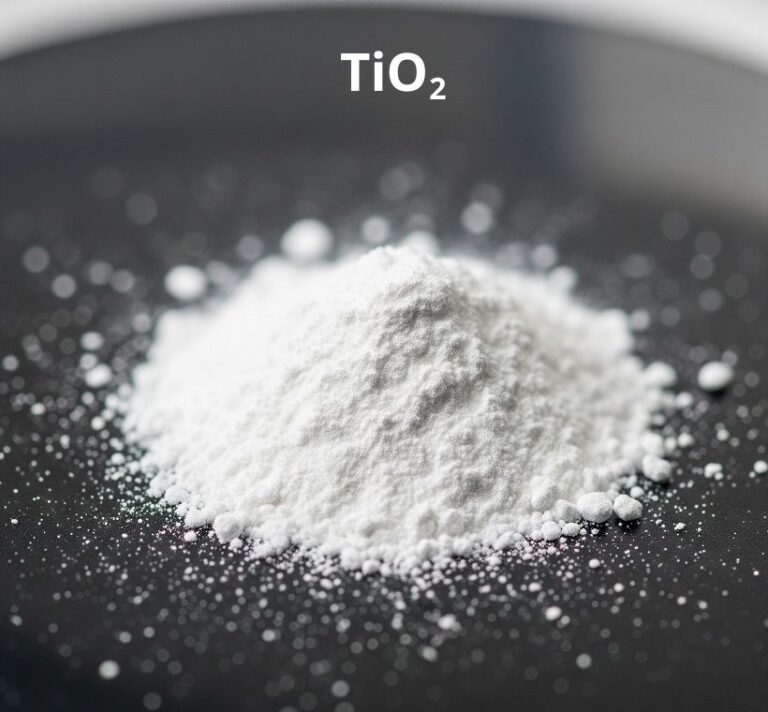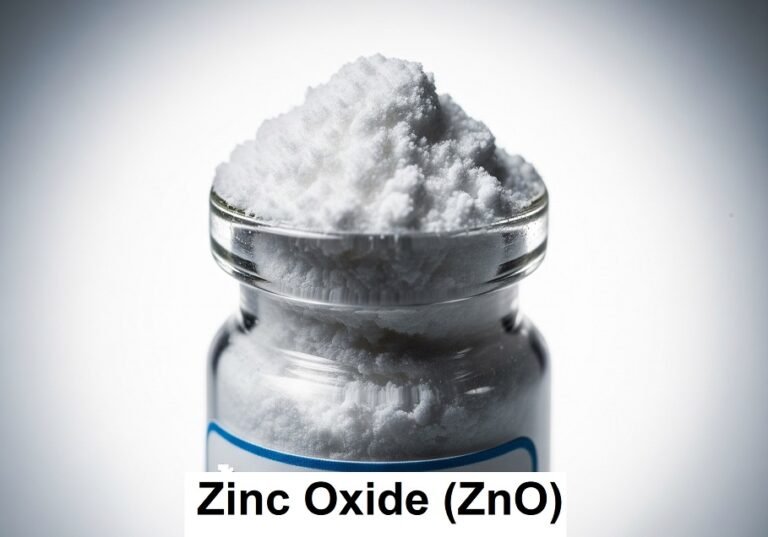
Antimony trioxide (Sb2O3) is a white crystalline powder with a molar mass of 291.52 g/mol and a melting point of 656 °C. It has two forms: senarmontite (below 570 °C) and valentinite (above 570 °C).
Senarmontite has a density of 5.25 g/cm3, while valentinite has a density of 5.7 g/cm3. Antimony trioxide is soluble in acids and alkalis.
Table of Contents
1. Production of Antimony trioxide
Antimony trioxide can be produced by roasting antimony trisulfide, burning antimony in an oxygen-rich environment, or hydrolyzing antimony halides or antimony trisulfide.

1.1. Roasting of Antimony Sulfide
Antimony trioxide can be produced from sulfide compounds by two methods: volatilizing roasting and nonvolatilizing roasting. Volatilizing roasting produces volatile antimony trioxide, which can be separated from the residue. Nonvolatilizing roasting produces nonvolatile Sb2O4, which remains mixed with the residue.
Volatilizing roasting is the preferred method because it yields a purer product. However, it is more challenging to control the temperature and draft in the furnace during this process.
The fundamental reaction for volatilizing roasting is:
2 Sb2S3 + 9 O2 → 2 Sb2O3 + 6 SO2
Excess oxygen can lead to the formation of Sb2O4:
Sb2S3 + 5 O2 → Sb2O4 + 3 SO2
At temperatures exceeding 560 °C, the reaction rate notably diminishes. During roasting, Sb2O4 can also react with Sb2S3 to produce antimony trioxide:
Sb2S3 + 9 Sb2O4 → 10 Sb2O3 + 3 SO2
Therefore, careful engineering of the process is necessary to ensure rapid and preferential formation of Sb2O3. The temperature must be adequately high to promote volatilization, while the oxygen supply must be limited to prevent the formation of Sb2O4.
However, excessively high temperatures can lead to the melting of some of the charge, enveloping the sulfide grains and impeding their oxidation. During the condensation of Sb2O3, it is essential to maintain a low oxygen content in the gas phase to prevent the oxidation of Sb2O4.
The temperature employed is dependent on the sulfide content of the ore. Low-grade ores can be roasted between 850 and 1000 °C. For rich ores, the upper temperature limit is the melting point of the sulfide (546 °C).
In practice, temperatures should not exceed 400 °C. Control of the oxygen supply is achieved by incorporating wood charcoal or coke breeze into the charge and admitting only the necessary air to form carbon monoxide and antimony trioxide.
Carbon monoxide serves to suppress the formation of Sb2O4. Nevertheless, the complete prevention of Sb2O4 formation is challenging.
The yield of the process varies depending on the specific method employed and the sulfide content of the ore, ranging from 60% to 90% or more.
Commercial Sb2O3 should contain a minimum of 99.5% antimony trioxide. Quality is also assessed based on its crystalline fineness, adhesion to surfaces, and the absence of caking. A reddish tinge in the oxide suggests the presence of Sb2S3, while a yellowish shade is undesirable and indicative of selenium and PbO contamination.
The acceptable arsenic content should be around 0.1%.
Refined commercial antimony trioxide can be produced through a secondary roasting process, where crude oxide undergoes controlled roasting conditions. This separation process is especially critical for obtaining high-quality Sb2O3, with arsenic oxide having little value.
Mercury-containing Sb ores typically require roasting at temperatures below 400 °C to volatilize the mercury, with precise temperature control necessary to avoid overheating and the volatilization of Sb compounds.
The roasted ore, still containing Sb2S3, is then slowly cooled under oxygen exclusion before undergoing reduction or iron precipitation in open-hearth furnaces.
Modern roasting furnaces commonly employ rotary kilns. These kilns can achieve antimony trioxide yields of 95 – 98% with high throughput, independent of the ore’s nature. They are suitable for oxide-sulfide ores, reducing the Sb to the metal initially and subsequently oxidizing it to Sb2O3, free of nonvolatile impurities and off-gases produced during reduction.
Some rotary kilns use hot air for heating, which reduces gas flow rates and minimizes gangue entrainment but may still lead to temperature fluctuations resulting in charge melting.
Crude Sb2O3, produced at approximately 81% Sb, 0.3% As, and 0.15% Ni, can be obtained through a volatilizing roast of sulfide concentrate in a rotary kiln. Temperatures during this process range from 1100 – 1200 °C.
The oxidation of Sb2S3 to Sb2O3 partly occurs in the gas phase. Notably, this conversion process utilizes the Chemetron Process, which incorporates unique features in oxidation and cooling control.
While Sb2O3 is continuously removed from the kiln, nonvolatile elements remain within the kiln and are removed periodically during deslagging campaigns. Critical process control parameters include kiln-feed rates, burner positioning, and cooling rates, which influence product
1.2. Recovery of Antimony Oxide
Antimony trioxide, also known as antimony(III) oxide, is a widely used flame retardant. Its demand has increased in recent years, and it is primarily produced by roasting antimony sulfide ores or other antimony-containing raw materials.
To obtain high-purity antimony trioxide, especially to separate arsenic from antimony trioxide, a selective volatilization process is used. This involves preferentially vaporizing the more volatile arsenic trioxide and then selectively condensing the less volatile antimony tetroxide at high temperatures. This process results in the condensation of arsenic trioxide at lower temperatures.
Another method for recovering antimony trioxide from complex antimony sulfide ores is to react them with calcium chloride. This reaction takes place in an oxidizing atmosphere at around 500 °C, as shown in the equation below:
Sb2S3 + 3 CaCl2 + 6 O2 → 2 SbCl3 + 3 CaSO4
During this process, over 90% of the antimony is volatilized as SbCl3, which can then be purified by distillation and hydrolysis to produce antimony trioxide.
2. Uses of Antimony Oxide

Antimony trioxide is a versatile material with a wide range of applications, broadly classified into flame-retardant and non-flame-retardant uses.
2.1. Flame-retardant applications:
- Poly(vinyl chloride) (PVC): antimony trioxide is commonly used in combination with a halogen source, such as chlorinated alkyd resin, poly(vinyl chloride) resin, or a chlorinated plasticizer, to impart flame-retardant properties to PVC. This combination is effective in preventing the release of flammable gases during combustion. It is used in conveyor belts for mines, cable coatings, and coated fabrics for applications like wall covering and cushion covers.
- High-impact polystyrenes (HIPS): antimony trioxide is used in HIPS for products like television backs, domestic electrical appliances, and housings for electrical equipment, including computers (PCs).
- Polyethylene and polypropylene: These plastics incorporate antimony trioxide primarily for wire sheathing and electrical conduits used in building applications.
- Polyamides and engineering plastics: antimony trioxide is employed in materials such as nylons, which find use in automotive components, industrial equipment, and electrical molded parts. Its flame-retardant properties enhance safety in these applications.
- Antimony trioxide is added to unsaturated polyesters in applications like building panels, automotive parts, and lifeboat hulls, where fire resistance is essential.
2.2. Non-flame-retardant applications:
- Pigments: antimony trioxide is utilized in pigments, particularly in the manufacture of chromate pigments. These pigments serve various purposes in the coloration of materials.
- Opacifier for ceramic glazes and frit: In ceramics, antimony trioxide functions as an opacifier for glazes and as a frit. It contributes to the opacity and appearance of ceramic products.
- Refining of lead crystal glass and glass for television tubes: antimony trioxide plays a vital role in the refining of lead crystal glass and glass used for television tubes. It helps remove unwanted color and gas bubbles from the glass, enhancing its clarity and quality. Sodium antimonate may also be used for similar purposes.
- Polymerization catalyst: antimony trioxide is used as a catalyst in the production of polyester fibers. It promotes the polymerization process, leading to the creation of polyester fibers used in various textile and industrial applications.
The demand for antimony trioxide has grown significantly since around 1970, reflecting its importance in various sectors. The global antimony trioxide market is projected to reach $4.1 billion by 2028, according to a report by MarketsandMarkets.
The increasing use of antimony trioxide in flame-retardant applications is the primary driver of market growth. The growing demand for plastics in various industries, such as automotive, construction, and electronics, is also fueling the market growth.
3. Toxicology

Antimony trioxide is a toxic compound that can cause a variety of health problems, including:
- Acute oral poisoning: Symptoms can include vomiting, diarrhea, and abdominal pains.
- Chronic respiratory intoxication: Symptoms can include soreness, nosebleeds, rhinitis, pharyngitis, pneumonitis, and tracheitis.
- Long-term exposure: Can result in lung X-rays similar to those seen in pneumoconiosis. Workers exposed to antimony trioxide for extended periods may develop pneumoconiosis and emphysema.
- Cancer: Antimony trioxide is suspected to be a carcinogen in humans.
The TLV (threshold limit value) for antimony trioxide is 0.5 mg/m3 (as Sb). This means that workers should not be exposed to levels of antimony trioxide in the air that exceed 0.5 mg/m3.
The TCLo (lowest observed chronic toxicity level) for antimony trioxide is 4.2 mg/m3 during 52 weeks. This means that exposure to antimony trioxide at levels of 4.2 mg/m3 for 52 weeks or longer can cause chronic health problems.
Reference
- Antimony and Antimony Compounds; Ullmann’s Encyclopedia of Industrial Chemistry. – https://onlinelibrary.wiley.com/doi/10.1002/14356007.a03_055.pub2



